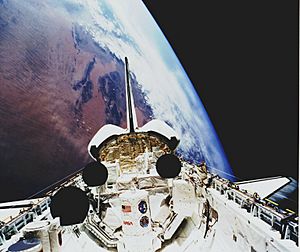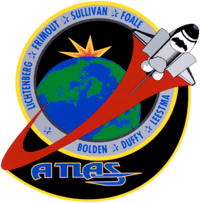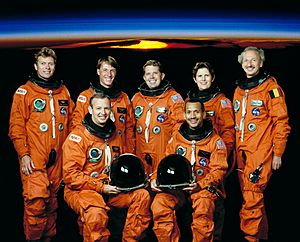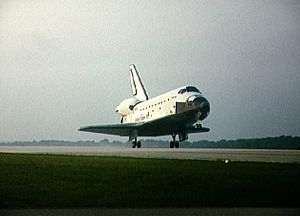STS-45 facts for kids

Parts of the ATLAS-1 laboratory inside Atlantis
|
|
| Names | Space Transportation System-45 |
|---|---|
| Mission type | Astronomy research |
| Operator | NASA |
| Mission duration | 8 days, 22 hours, 9 minutes, 28 seconds (achieved) |
| Distance travelled | 5,211,340 km (3,238,180 mi) |
| Orbits completed | 143 |
| Spacecraft properties | |
| Spacecraft | Space Shuttle Atlantis |
| Launch mass | 105,982 kg (233,650 lb) |
| Landing mass | 93,009 kg (205,050 lb) |
| Payload mass | 9,947 kg (21,929 lb) |
| Crew | |
| Crew size | 7 |
| Members |
|
| Start of mission | |
| Launch date | 24 March 1992, 13:13:39 UTC |
| Rocket | Space Shuttle Atlantis |
| Launch site | Kennedy Space Center, LC-39A |
| Contractor | Rockwell International |
| End of mission | |
| Landing date | 2 April 1992, 11:23 UTC |
| Landing site | Kennedy Space Center, SLF Runway 33 |
| Orbital parameters | |
| Reference system | Geocentric orbit |
| Regime | Low Earth orbit |
| Perigee | 282 km (175 mi) |
| Apogee | 294 km (183 mi) |
| Inclination | 57.00° |
| Period | 90.30 minutes |
 STS-45 mission patch  Standing: Byron K. Lichtenberg, C. Michael Foale, David C. Leestma, Kathryn D. Sullivan, Dirk Frimout Seated: Brian Duffy, Charles F. Bolden Jr. |
|
STS-45 was a special NASA Space Shuttle mission that took place in 1992. It used the Space Shuttle Atlantis (also known as OV-104). This mission was all about science, lasting almost nine days.
The main goal was to study Earth's atmosphere and the Sun using many different instruments. These instruments were carried inside the shuttle's cargo bay. STS-45 was the 46th Space Shuttle mission and the 11th time Atlantis flew into space.
Contents
Meet the Astronauts
The STS-45 mission had a crew of seven brave astronauts. They worked together to complete all the scientific experiments.
| Position | Astronaut | |
|---|---|---|
| Commander | Third spaceflight |
|
| Pilot | First spaceflight |
|
| Mission Specialist 1 | Third and last spaceflight |
|
| Mission Specialist 2 | Third and last spaceflight |
|
| Mission Specialist 3 | First spaceflight |
|
| Payload Specialist 1 | Only spaceflight |
|
| Payload Specialist 2 | Second and last spaceflight |
|
- Commander: Charles F. Bolden Jr. led the mission. This was his third trip to space.
- Pilot: Brian Duffy helped fly the shuttle. This was his first space flight.
- Mission Specialists: Kathryn D. Sullivan, David C. Leestma, and C. Michael Foale were in charge of the mission's scientific tasks. Kathryn and David were on their third and last flights, while Michael was on his first.
- Payload Specialists: Dirk Frimout from Belgium and Byron K. Lichtenberg from the USA were scientists who managed the experiments. Dirk Frimout was the first Belgian citizen to fly into space.
Mission Journey
The Space Shuttle Atlantis launched on March 24, 1992. It took off from the Kennedy Space Center in Florida. The launch was delayed by one day because of a small issue with gases in the shuttle's back section. Engineers fixed it quickly. At launch, Atlantis weighed about 105,982 kilograms (233,650 pounds).
What Was Carried on Board?
The main part of the mission was the first Atmospheric Laboratory for Applications and Science (ATLAS-1). This was a set of 12 science instruments. They were placed on special platforms inside the shuttle's cargo bay. These instruments were from different countries, including the United States, France, Germany, Belgium, Switzerland, the Netherlands, and Japan.
The ATLAS-1 instruments studied many things:
- Atmospheric Chemistry: How gases in Earth's air interact.
- Solar Radiation: The energy coming from the Sun.
- Space Plasma Physics: How electrically charged gases behave in space.
- Ultraviolet Astronomy: Looking at stars and galaxies using ultraviolet light.
Some of the cool instruments included the Atmospheric Trace Molecule Spectroscopy (ATMOS) and the Far Ultraviolet Space Telescope (FAUST). There were also other smaller experiments on board.
Mission Extension and Landing
The mission was so successful that it was extended by one day. This allowed the astronauts to do even more science experiments.
Atlantis landed safely on April 2, 1992. It touched down on Runway 33 at the Shuttle Landing Facility in the Kennedy Space Center. The shuttle weighed about 93,005 kilograms (205,039 pounds) when it landed.
Mission Patch Meaning
The STS-45 mission patch tells the story of the flight. It shows Earth and the Sun, with the shuttle flying in a high orbit. This highlights the important scientific goals of the mission.
The names of all the astronauts are on a band around the patch, separated by stars. There's also a special star for the backup crew members, showing they were part of the team too. The patch also includes "ATLAS," which was the main scientific project.



